Implantation
Today one method of providing a supplement for a missing tooth is dental implantation, when – by applying local anaesthetics - one or more titanium ‘root’ devices are placed within the jawbone.
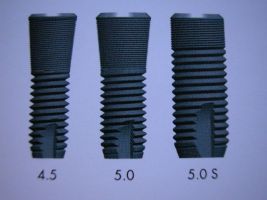
Implants with different diameters
The implantation may be performed with a comparatively simple operation if the dimensions of the bone are adequate. If they weren’t, the implant screw would fall out. In other cases complementary procedures may be required (such as lifting the base of the maxillary sinus with a bone expletive substance, bone transplantation, application of supplements to the jawbones with bone expletive substances) in order to thicken the inadequate part of the bone. The most important factor of a successful implantation is the careful and detailed planning. Photographs, X-ray shots, surgical stents, gypsum and plastic musters are used.
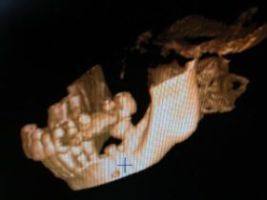
3 dimensions view of CT
Today in most of the cases the taking of a CT (computer tomography) scan is indispensable (a special version of the CT scanning - developed specially for dental purposes /Cone-Beam CT/ - is available in Hungary.) According to these scans a computerised 3D planning of the location of the implant may be planned and the dimensions of the bone or the bone density may be measured.
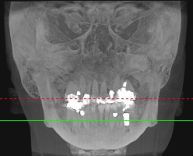
Frontal view of CT
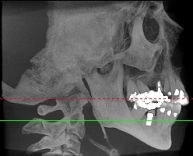
Lateral view of CT
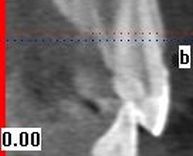
Cross section view of incisor
An other important prerequisite of the long-term success of an implantation is perfect dental hygiene (coat-, plaque- and scale-free teeth, no gum diseases) and a check-up in every 6 months.
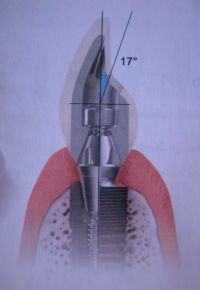
Implant with crown in the bone
The implant may supplement for a missing tooth and may serve as a support for dental prostheses, in which case it is
possible to make a fixed restoration (bridge) instead of a removable prosthesis.
It may notably improve the ability to chew at edentulous jaw sites, even if the number of implants is not sufficient for
preparing a bridge prosthesis, but a couple of implants anchor the denture, in a similar way as a snap fastener. Especially
in case of the full lower denture - which almost always moves - can the implantation of even two implants have a very
favourable outcome.
Implants may be placed immediately after the extraction of the tooth (so-called immediate post-extraction implant placement)
and to jaw sites where the tooth has been missing for a longer time. After the extraction the appointment for the implantation
can be settled and in the meantime a temporary prosthesis may be used.
Implants are drilled in the jaw with local anaesthetics (no pain is felt) and in the simplest of cases the procedure may be
performed in thirty minutes. The inconvenience after the operation is not more unpleasant than the feeling after a tooth
extraction (or it may be even less).
In more complicated cases – depending on how long the operation lasted, etc. – the usual post-surgical state can be expected
(bloated face, sensitivity, etc.). See:
‘Information on Surgeries’.
In order for the implant to perfectly settle in the bone in case of the upper denture a 6-month period, in case of the lower
denture a 4-month period is needed (two-phase implantation method). This is followed by the placement of the
‘superstructure’, which can either be a crown, a bridge or a ‘snap fastener’ holding a prosthesis. For the 6-month period of
the healing a temporary prosthesis is to be used.
In some cases the superstructure can be placed upon the implant at the time of the implantation (or it may be fixed to the
body of the implant) so-called one-phase implantation method.
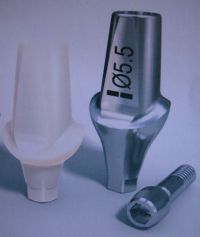
Metal- and metal free implant abutment
The material of the superstructure (the head part) is titanium but where aesthetic aspects have to be taken into consideration
it is possible to apply metal-free crowns on top of the metal-free (zirconium) head parts.
The life-expectancy of the implants is many decades but it is necessary to have proper dental hygiene and to appear at check-ups
once in every 6 months. The implants will not be rejected by the body as they are made of titanium and nobody has been known so
far to be allergic to it. The most common reason for losing an implant is an inflammation around it because of improper hygiene,
therefore it is important to undergo regular check-ups.
We apply two types of implantation systems at our dental surgery:
- DenTi (one of the most commonly used devices, developed in Hungary, manufactured by the German Meissinger company. It has been in use in Hungary for more than 25 years).
- Astra Tech (Swedish system), one of the best implantation systems – if not the best – in the world.
Procedures applied at our dental surgery:
- surgical planning in 3D on the basis of a CT scan,
- immediate post-extraction tooth placement (one- or two-phase implantation),
- delayed post-extraction implant placement (one- or two-phase implantation),
- bone graft procedure (bone augmentation) (materials commonly used are: Bio-Oss bone graft substitute, BioGide membrane (Geistlich Biomaterials, Switzerland), Frios titanium web (Dentsply-Friadent, Germany),
- filling of the base of the maxillary sinus with a bone graft substitute (performed at the same time of the implantation or at a different appointment),
- augmentation of the jawbones with a bonet substitute,
- aesthetic correction of the gums with surgery.
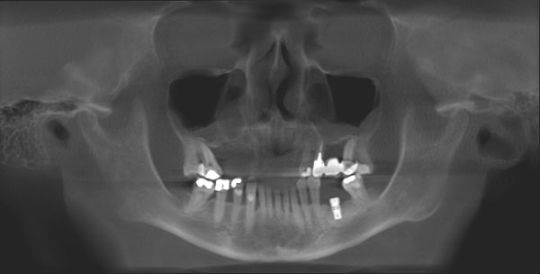
Panoramic view of CT
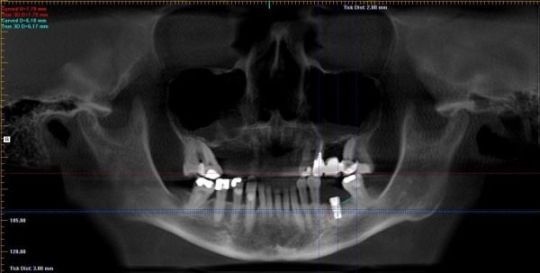
Measurements on CT